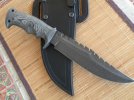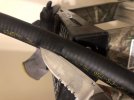When I used to keep using a knife after it got dull, I found that a half-dull serrated blade continued “cutting” (really more like tearing and gouging, with more effort) longer than a half-dull straight blade.
When I learned to sharpen better, I lost my tolerance for dullness. I started carrying a pocket stone or hone and got in the habit of sharpening immediately after dulling. Then the serrated blade lost the advantage for most of my cutting. Now I usually carry straight edge knives.
To expand a little on what SALTY mentioned about sawing, a saw is a completely different animal than a serrated blade. Saw steeth cut a kerf, which creates clearance and access to the material beneath that just cut. All the serrations I’ve seen are extensions of a wedge shape, which has to force the sides apart to cut deeper. This is problematic in a material like wood fiber, which doesn’t move aside for the wedge. Whole different animal.
All that said, I have an old SOG multitool with both straight and serrated blades. I LOVE it for hiking/camping/bushcrafty stuff.
Parker
When I learned to sharpen better, I lost my tolerance for dullness. I started carrying a pocket stone or hone and got in the habit of sharpening immediately after dulling. Then the serrated blade lost the advantage for most of my cutting. Now I usually carry straight edge knives.
To expand a little on what SALTY mentioned about sawing, a saw is a completely different animal than a serrated blade. Saw steeth cut a kerf, which creates clearance and access to the material beneath that just cut. All the serrations I’ve seen are extensions of a wedge shape, which has to force the sides apart to cut deeper. This is problematic in a material like wood fiber, which doesn’t move aside for the wedge. Whole different animal.
All that said, I have an old SOG multitool with both straight and serrated blades. I LOVE it for hiking/camping/bushcrafty stuff.
Parker



